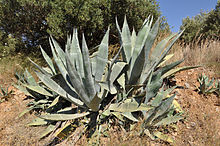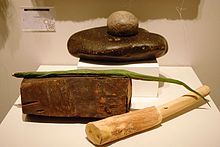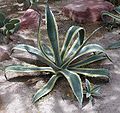- Agave americana
-
Agave americana 
Scientific classification 
Kingdom: Plantae clade: Angiosperms clade: Monocots Order: Asparagales Family: Asparagaceae Subfamily: Agavoideae Genus: Agave Species: A. americana Binomial name Agave americana
L., 1753[1]Agave americana, commonly known as the century plant, maguey, or American aloe (although it is in a different family from the Aloe),[2] is an agave originally from Mexico but cultivated worldwide as an ornamental plant. It has since naturalised in many regions and grows wild in Europe, South Africa, India, and Australia.[3]
Contents
Description
The misnamed century plant typically lives only 10 to 30 years. It has a spreading rosette (about 4 m/13 ft wide) of gray-green leaves up to 2 m (6.6 ft) long, each with a spiny margin and a heavy spike at the tip that can pierce to the bone.
When it flowers, the spike with a cyme of big yellow flowers may reach up to 8 m (26 ft) in height. Its common name likely derives from its semelparous nature of flowering only once at the end of its long life. The plant dies after flowering, but produces suckers or adventitious shoots from the base, which continue its growth.
Taxonomy and naming
Agave americana was one of the many species described by Carl Linnaeus in the 1753 edition of Species Plantarum, with the binomial name that we still use today.
Cultivars
Cultivated varieties (cultivars) include:[4][5]
- 'Marginata' with yellow stripes along the margins of each leaf
- 'Mediopicta Alba' with a central white band
- 'Mediopicta Aurea' with a central yellow band
- 'Striata' with multiple yellow to white stripes along the leaves
- 'Variegata' with white edges on the leaves.
Subspecies
Subspecies and varieties of Agave americana include:
- Agave americana var. americana
- Agave americana var. expansa
- Agave americana var. latifolia
- Agave americana var. oaxacensis
- Agave americana ssp. protamericana
Uses
Tools used to obtain agave's ixtle fibers, at the Museo de Arte Popular, Mexico City D.F.
Culinary
If the flower stem is cut without flowering, a sweet liquid called agua miel ("honey water") gathers in the heart of the plant. This may be fermented to produce the drink called pulque. The leaves also yield fibers, known as pita, which are suitable for making rope, matting, coarse cloth and are used for embroidery of leather in a technique known as piteado. Both pulque and maguey fibre were important to the economy of pre-Columbian Mexico.
Mezcal and tequila are different from pulque, they are distilled spirits. In the region of Tequila, agaves are called mezcales, and the high-alcohol product of their distillation is called mezcal. Tequila is made from Agave tequilana, comonly called "blue agave". Mezcal may contain the mezcal worm, which pulque and tequila do not.
Agave nectar, also called agave syrup, is marketed as a natural sugar substitute with a low glycemic index that is due to its high fructose content.
- Heraldry
The plant figures in the coat of arms of Don Diego de Mendoza, a Native American governor of the village of Ajacuba, Hidalgo state.[6] The sap is quite acidic and can be quite painful if it comes in contact with the skin. It can form small blisters.
Cultivation
""Agave americana is cultivated as an ornamental plant for the large dramatic form of mature plants - for modernist, xeriscape|drought tolerant]], and 'desert style cactus gardens' - among many planted settings [7] The plants can be evocative of 18th-19th century Spanish colonial and Mexican provincial eras in the Southwestern United States, California, and xeric Mexico.
Gallery
-
in Rookwood Cemetery, Sydney, Australia
-
Agave (americana), Yemen
-
In full bloom in San Francisco, California, USA
See also
- Purpuric agave dermatitis
- Agave nectar
- Maguey worm
- Mezcal
- Piteado
- Pulque
References
- ^ "Agave americana L.". Germplasm Resources Information Network. United States Department of Agriculture. 2005-05-23. http://www.ars-grin.gov/cgi-bin/npgs/html/taxon.pl?1690. Retrieved 2010-01-12.
- ^ Bailey, L.H.; Bailey, E.Z.; the staff of the Liberty Hyde Bailey Hortorium. 1976. Hortus third: A concise dictionary of plants cultivated in the United States and Canada. Macmillan, New York.
- ^ Irish, Gary (2000). Agaves, Yuccas, and Related Plants: A Gardener's Guide. Timber Press. pp. 94–97. ISBN 9780881924428. http://books.google.com/books?id=YbVYuq73I0wC.
- ^ Vermeulen, Nico. 1998. The Complete Encyclopedia of Container Plants, pp. 36-37. Netherlands: Rebo International. ISBN 90-366-1584-4
- ^ Royal Horticultural Society Database : Agave americana, retrieved 2011-07-28
- ^ pacbell.net/nelsnfam/mexico
- ^ NPIN - Information . accessed 11.1.2011.
External links
- USDA PLANTS Profile for Agave americana (American century plant)
- Lady Bird Johnson Wildflower Center Native Plant Information Network (NPIN) - Agave americana
Categories:- Agave
- Flora of Northeastern Mexico
- Flora of Northwestern Mexico
- Flora of Central Mexico
- Flora of the Chihuahuan Desert
- Flora of Texas
- Flora of Sonora
- Flora of Coahuila
- Flora of Tamaulipas
- Flora of Nuevo León
- Flora of San Luis Potosí
- Flora of Oaxaca
- Flora of Jalisco
- Flora of Queretaro
- Flora of Veracruz
- Flora of Arizona
- Flora of California desert regions
- Plants described in 1753
- Our Lady of Guadalupe
- Invasive plant species in South Africa
- Crops originating from Mexico
- Fiber plants
- Medicinal plants
- Traditional Native American medical plants
- Garden plants of North America
- Drought-tolerant plants
Wikimedia Foundation. 2010.

















